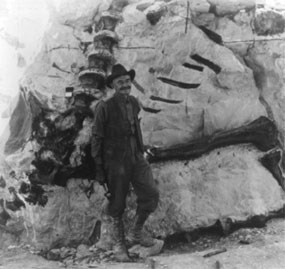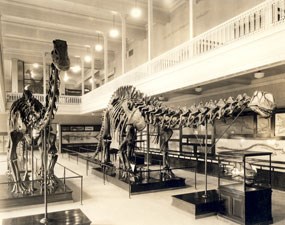
Special Collections Dept. Earl Douglass was a paleontologist at the Carnegie Museum in Pittsburgh, Pennsylvania. In 1909, he found eight dinosaur tailbones protruding from a sandstone hill in the Utah desert. This discovery was the beginning of a dinosaur quarry that achieved worldwide fame. In 1915, Dinosaur National Monument was established to protect and conserve that dinosaur quarry. In the summer of 1909, Earl Douglass traveled to Utah to search for dinosaur skeletons. A few years earlier, the Carnegie Museum had collected a nearly complete Diplodocus skeleton in Wyoming. The huge skeleton had been mounted and displayed in the museum's new Dinosaur Hall and it enthralled the public. The Carnegie Museum was eager to find more dinosaur skeletons to populate their Dinosaur Hall. Douglass-Early Life Fossil Prospecting in Utah The year before, while passing through the area east of Vernal, Douglass and Holland had found a Diplodocus femur. The fossil was too large and heavy for them to move, but it was promising. Holland described the find as "proof positive that in that general region search for dinosaurian remains would probably be successful." Arriving at the dinosaur beds near Vernal, Douglass was not encouraged by what he found. On August 10, his first day there, he discovered that "someone had taken the best of the bones that were exposed." His August 12 diary entry lamented that he had "[f]ound dinosaur bones but nothing good." On August 13: "The layer contains fragments of bones but nothing especially promising." On August 16: "The bones were terribly broken up and it seemed as if they had been churned up…Felt rather discouraged." Douglass began to excavate the bones. As he worked, he found fossils from other dinosaurs mixed with the Apatosaurus skeleton. This was the beginning of the Carnegie Quarry. With the discovery of the Apatosaurus, Douglass was no longer on a brief summer-long fossil collecting expedition. The fossils he had found were now his full-time job and the Utah desert his new workplace. His wife, Pearl, and year-old son, Gawin, joined Douglass in Utah in September of 1909. The family eventually established a ranch not far from the quarry, where they lived until 1923. 
Carnegie Museum of Natural History
After the Discovery Douglass, however, remained at the quarry and in the employ of the Carnegie Museum. In 1923 and 1924, he worked with the National Museum-part of the Smithsonian Institution-and with the University of Utah in their quests to obtain dinosaur fossils at the famous quarry. In 1924, all excavation at the quarry ended and Douglass resigned from the Carnegie Museum. He joined the staff of the University of Utah where he spent two years preparing fossils from the quarry for mounting. His final years were spent as a geologist, specializing in the Uintah Basin. Earl Douglass, who died in 1931, played a central role in one of the most important fossil finds in North America. The "beautiful sight" Douglass saw on August 17, 1909, turned out to be one of the most productive Jurassic era quarries ever found. The quotes and excerpts from Earl Douglass's diaries used on this page are taken from Speak to the Earth and It Will Teach You, The Life and Times of Earl Douglass, 1862-1931 by G.E Douglass. |
Last updated: February 24, 2015
